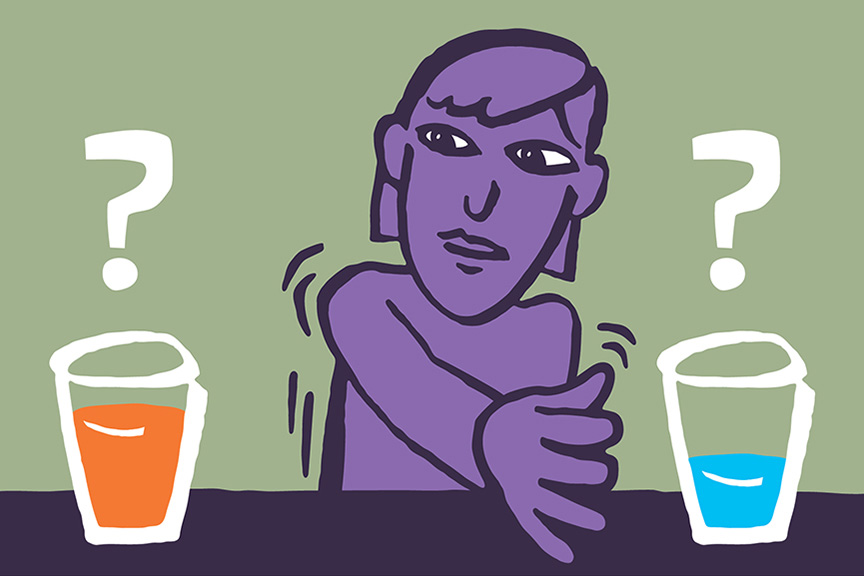Ballesta* S, Shi* W, Conen KE, Padoa-Schioppa C. Nature. Nov 2, 2020; 588(7838)450-453.
*Co-first authors
Abstract
In the eighteenth century, Daniel Bernoulli, Adam Smith and Jeremy Bentham proposed that economic choices rely on the computation and comparison of subjective values. This hypothesis continues to inform modern economic theory and research in behavioural economics, but behavioural measures are ultimately not sufficient to verify the proposal. Consistent with the hypothesis, when agents make choices, neurons in the orbitofrontal cortex (OFC) encode the subjective value of offered and chosen goods. Value-encoding cells integrate multiple dimensions, variability in the activity of each cell group correlates with variability in choices and the population dynamics suggests the formation of a decision. However, it is unclear whether these neural processes are causally related to choices. More generally, the evidence linking economic choices to value signals in the brain remains correlational. Here we show that neuronal activity in the OFC is causal to economic choices. We conducted two experiments using electrical stimulation in rhesus monkeys (Macaca mulatta). Low-current stimulation increased the subjective value of individual offers and thus predictably biased choices. Conversely, high-current stimulation disrupted both the computation and the comparison of subjective values, and thus increased choice variability. These results demonstrate a causal chain linking subjective values encoded in OFC to valuation and choice.
Department mini interview
In this article, you demonstrate that neuronal activity in the orbitofrontal cortex is causally related to economic choices. Could you define what is an economic choice?
Camillo Padoa-Schioppa: Economic choice is the behavior observed when people or animals select between different options based on subjective preferences. For example, we make an economic choice when we choose between different dishes on a restaurant menu, or when we choose between different financial investments.
Do your results mean that you identified the biological substrate for the computations underlying economic choices?
Sébastien Ballesta: Economic choice is thought to entail two computations. First, subjects assign a value to each option. Second, they make a decision by comparing these values. This idea has been around for three centuries, but it was never proven. In essence, our study demonstrates that indeed choices are based on the computation of values.
That sounds very intuitive. What took you so long? Why was this hypothesis not proven until now?
Camillo Padoa-Schioppa: Behaviorally, it is impossible to measure values independent of choices. This creates a circularity problem, which is why economists could never prove that values are “real.” In the past 15 years, my lab and other labs have shown that neurons in several brain regions represent subjective values. That was a big step forward. However, values are relevant to many cognitive functions, such as learning, attention, and emotion. Thus the presence of value signals in the brain does not imply that choices are based on values. Establishing a causal link between values and choices has been difficult for technical reasons. In this study we were able to do so because we introduced two new experimental paradigms.
Why was it difficult to prove causality?
Weikang Shi: To establish causality between the activity of some neuronal population and a particular behavior, one must show that altering the activity of that population predictably biases the behavior. This is typically done by injecting a small electric current in the brain, which increases the firing rate of neurons close to the electrode. In many cortical areas, neurons are organized in columns. In other words, neurons that are close to each other represent the same variable. This makes it easier to prove causality because the electric current has a “unanimous” effect. The difficulty in using this approach for economic decisions is that orbitofrontal cortex does not have a columnar organization. Consequently, electric currents increase the firing of neurons supporting both choices.
How did you overcome this challenge?
Sébastien Ballesta: The experimental paradigms we introduced in this study circumvent this challenge in two ways. In one experiment, the two goods available for choice were offered in sequence. Electrical stimulation was delivered during one of the two offers, and it affected only that offer. In another experiment, we took advantage of a phenomenon named “range adaptation.” Basically, we were able to increase the value of both offers, but one of the two values increased more. As a result, choices were biased in favor of that offer.
How did this study begin? What prompted it?
Camillo Padoa-Schioppa: We first discovered that neurons in orbitofrontal cortex encode values 15 years ago, when I was a post-doc. For a number of reasons I suspected that these values were causally linked to choices, but I did not know how to prove it. The turning point came when we thought of the experimental paradigms described by Sebastien. The key idea –taking advantage of range adaptation – came from my then graduate student Kati Conen (a co-author on the paper). At the time, Kati was finishing her PhD and thinking about her next steps, and could not carry out the project herself. So when Sebastien and Weikang joined the lab, they started working on these experiments, which ended up working even better than we had hoped.
How do you think your study will advance the field, and impact modern behavioral science and behavioral economics?
Camillo Padoa-Schioppa: I think that the impact will be two-fold. From the point of view of neuroscience, these results provide important information on the neural circuit responsible for choices. In particular, they highlight the key role of different groups of neurons identified in the orbitofrontal cortex. The next step is to investigate this neural circuit in greater detail, to really understand the mechanisms underlying choices. From the point of view of economics, our results validate a long-held hypothesis. Together with other work from my lab and other labs, they provide the elements to develop new and more biologically inspired economic models. This is one of the ultimate goals of neuroeconomics.
